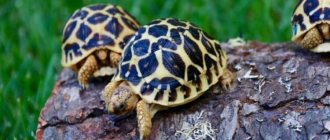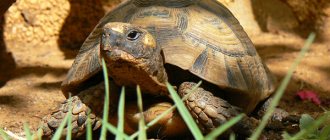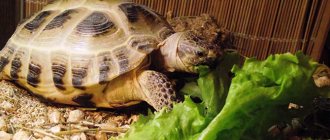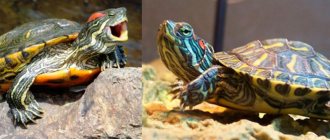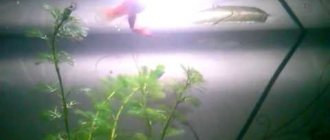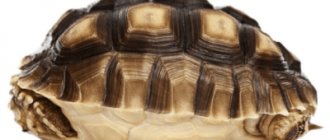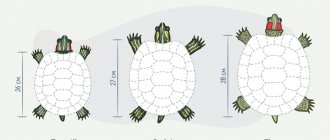Review author: “ZooVita”
Red-eared sliders are a common species of freshwater reptile that adapts well to any habitat. This feature has contributed to their popularization among breeders around the world. Turtles are called "red-eared" turtles because of the red spots located behind their eyes. It is they who distinguish this type of amphibian and make them recognizable.
If you provide the necessary care for red-eared turtles at home, they can become beloved pets and live up to 30 years. Animals are quite hardy, but can get sick or die in unsuitable conditions.
How to organize an acquaintance correctly
Before purchasing, you need to study all the necessary information: look at a photo of a red-eared turtle, get advice on its contents from a seller in a pet store, read reviews from the owners.
It is necessary to evaluate your capabilities, because creating comfortable conditions for an animal requires time and financial costs. Young individuals require daily attention and a special diet.
It is better to buy a turtle in a specialized pet store, where it was provided with proper care, than in the market from random sellers. In this case, the likelihood of acquiring a healthy pet increases.
In any case, getting acquainted with a reptile should begin with a veterinarian to make sure that it does not have diseases. This is especially true for those who already have similar or other pets.
IMPORTANT! You should not place the red-eared turtle with its relatives. Adult turtles are aggressive towards young ones and can injure them. It is better to place the new family member separately, giving him time to adapt.
If there is a child in the house, he needs to explain that he should not often pick up the turtle or bother him.
At home
Before you bring a red-eared turtle into your home, you should familiarize yourself with a number of requirements on how to properly handle this animal. When buying a turtle in pet stores or markets, take it to the veterinarian. Many sellers do not care about the health of their animals, and a veterinarian will be able to identify wounds, illnesses or infections. Before bringing your turtle home, create comfortable living conditions for it.
Features of the body
- Turtles have excellent color vision. They are able to see objects at a distance of 40 m, which helps them orient themselves in time if danger approaches.
- Hearing is poorly developed, they do not have auditory shells, and the ear openings are covered with a film and only pick up vibrations.
- The vocal cords can only produce a hiss, squeak, or snort when alarmed.
- Thanks to their developed sense of smell, these animals obtain suitable food for themselves in the natural environment or select it to taste at home.
- Nerve endings are located throughout the body, including the shell.
IMPORTANT! You should touch the turtle carefully and only when necessary. She is very sensitive and reacts even to a light touch.
- The color of a turtle can vary depending on the environment where it lives.
- An adult turtle reaches a size of 25–30 cm in length.
What to feed red-eared turtles?
Red-eared turtle diet
Red-eared turtles are omnivores and love to eat a wide variety of plants and animals: filamentous algae, snails, terrestrial insects, crustaceans, small vertebrates, etc.
However, the feeding frequency of turtles varies depending on age. So young turtles are fed daily, but adults only 2-3 times a week.
All young Red-eared turtles are primarily predators, therefore they need live food for active growth, which they are fed once a day (neither 2 nor 3). In addition, the aquarium must contain live plants (algae, lettuce leaves) as plant food. Adult Red-eared turtles (over 7 cm) are fed 3 – 4 times a week, and the amount of plant food approaches 50%.
Proper and nutritious nutrition for red-eared turtles will keep them healthy and playful for many years. The diet of domestic turtles must include plant foods (such as basil, aloe, oregano, peas, balsam, figs, clover, coleus, calendula, nettle, onions, dandelions, petunias, rose petals, barley, rose hips, cyperus, Kalanchoe, fern, hibiscus, lawn grass, coffee, plantain), vitamin and mineral supplements, fish (such as cod, hake, thalassa) and meat.
Red-eared turtle eating
But not all plants are useful for turtles, there are also poisonous ones (monstera, epipremnum, philodendron, anthurium, silent, acalyph, croton, jatrophe, azalea, delphinium, crocus, morning glory, lily of the valley, lupine, periwinkle, oleander, juniper, nightshade, ficus, philodendron, shefflera), some of which cause great harm to health even after touching. In some cases, eating these plants leads to disruption of the nervous system and gastrointestinal tract.
You should not include in the red-eared turtles’ diet such foods as are so familiar to us, such as: meat (minced meat, sausages, beef, pork, lamb, chicken, etc.), fatty fish, fruits, bread and cheese.
Please note that feeding aquarium fish and aquarium turtles must be correct: balanced and varied. This fundamental rule is the key to their successful maintenance.
Currently, dry food is, of course, popular and popular food for fish and turtles. For example, you can find food from Tetra, the leader of the Russian market, on aquarium shelves all the time and everywhere, having a range of food “for every taste.” Tetra’s “gastronomic arsenal” includes individual food for a specific type of fish: guppies, goldfish, cichlids, loricariids, labyrinths, arowanas, discus fish, etc. Tetra has also developed specialized foods, for example, to enhance color, fortified, or for feeding fry. You can find out detailed information about all Tetra feeds on the company’s official website - here .
It would not be amiss to note that when purchasing any dry food, you should first of all pay attention to the date of its manufacture and shelf life, try not to buy food in bulk, and also store the food in a closed state - this will help to avoid the development of pathogenic flora in it .
List of suitable products
- Beef, turkey, rabbit, chicken. Meat should be periodically subjected to short-term heat treatment, combined with raw meat, otherwise animals may develop rickets.
- Low-fat river fish: cod, carp, bream, pike perch, pollock, hake, sprat.
- Crustaceans, mollusks, squids.
- Liver, heart, stomachs.
- Insects: grasshoppers, earthworms, crickets.
IMPORTANT! It is safer to buy insects from pet stores. In their natural environment, they can be poisoned with chemicals. A poisoned insect is not suitable for food.
- Vitamins, supplements. The diet must contain calcium for proper development of bones and shell. It is added to products in the form of a special powder for reptiles. Due to the lack of calcium, the shell can become deformed or even fall apart in advanced cases.
- Vegetables: zucchini, broccoli, eggplant, bell pepper, grated carrots.
- Greens: meadow grass, lettuce.
- Dried seaweed.
- Aquatic vegetation: duckweed, spirogyra. Algae must be grown separately, otherwise the turtle may overeat on them.
Health and illness
Almost all problems with red-eared turtles occur due to illiterate care and non-compliance with maintenance rules. It is vital for the turtle's health to maintain a stable water temperature, as well as adhere to a number of rules for feeding and keeping the aquarium clean.
To keep your turtle healthy, monitor it properly. When a turtle is sick, it is necessary to increase the temperature to 30 degrees Celsius. The turtle's immunity is activated at this temperature. Make sure your turtle maintains the required amount of fluid in its body. You can also tell if your turtle is sick by the way it swims. If she swims only on one side, it means she is susceptible to some kind of disease. When you realize that something is wrong with your pet, do not delay and be sure to take him to the veterinarian!
Common diseases that the red-eared slider is susceptible to:
- Bacterial eye infection. The turtle's eyes become swollen and red. Sometimes she can't open them. Clean the water, check the temperature and tidy up the aquarium. As a treatment, the veterinarian prescribes antibiotic drops.
- Bacterial mouth infection. The turtle is not eating and small tumors have formed in its mouth. This disease requires serious treatment. Antibiotics are prescribed by a veterinarian.
- Pneumonia. Hemorrhages are visible on the shell. The turtle is weak, the shell is very soft. You should contact your veterinarian immediately.
All turtle diseases can be fatal if all necessary treatment measures are not taken in time and do not seek help from veterinarians.
Sexual characteristics
Keeping turtles does not require special professional knowledge; the main thing is to follow the recommendations of experienced breeders. However, when the question arises: how to determine the sex of a red-eared slider, some difficulties may arise.
The fact is that it is possible to distinguish a “boy” from a “girl” only when the individuals reach 2 years of age. Turtles finally become sexually mature at 6–8 years of age. At this age, they have characteristic features that classify them as female or male.
- Dimensions. Females are larger than males.
- Length of claws. The male has longer claws than the female. The paws of males have a pronounced spur, which makes them stronger.
FOR REFERENCE! In individuals of both sexes kept at home, the claws can wear down and take on a shorter shape than in the natural environment.
- Shell shape. The male has a concave abdominal shell, while the female has a regular one.
- Tail. The male's genital organ is located in the tail and is wider and longer than that of the female.
- Coloring. Males have a more aggressive coloration: pronounced red spots on the head and yellow furrows along the body. Females have a duller color.
- Features of behavior. The female has a calmer disposition. During the mating season, the male actively pursues the female, nods his head attractively and makes demonstrations.
Appearance
The red-eared turtle has a rather attractive appearance. The upper side of the shell has a rounded shape of a greenish-olive color, which is decorated with black and yellow stripes. The underside of the shell is smooth in texture with a yellowish tint and small dark spots. A red-eared slider's eyes begin to develop a distinctive red or orange stripe that extends to the neck area. Young turtles have a bright green shell color. Over the years, this color becomes faded, and the dark spots on the shell darken. Their size can range from 6 to 20 centimeters. However, size is not always a sign of a turtle's age, since with good nutrition in captivity, red-eared turtles are capable of reaching large sizes in a very short time.
The sense organs of this representative are remarkable. Their vision is so good that they are able to distinguish color palettes in and under water, as well as detect the movements of other animals up to 40 meters away. The sense of smell helps to find food. Hearing is relatively poorly developed compared to other senses. Turtles can only distinguish subtle sounds and various vibrations. They are also endowed with a sense of touch, which allows them to choose the taste of food.
Interesting facts about the red-eared slider
Hibernation. At home, turtles do not need to hibernate. Therefore, there is no need to create difficulties for yourself and irritate the animal by providing it with all the conditions for hibernation.
Aggressive behavior. Despite their non-combatant appearance, turtles can become extremely aggressive if they believe they are in danger. Even without teeth, they can painfully grab a finger in response to a possible threat.
Motherhood. Red-eared turtles are bad parents. Females lay eggs on land and leave them there. Representatives of both sexes do not take any part in nursing the cubs, leaving them to their fate.
The sex of the young depends on the temperature in the nest during the incubation period. At temperatures up to +27° Celsius, male cubs appear, and at +29° and above – female ones. With temperature changes - both sexes.
Care and maintenance
If possible, pick up the turtle with both hands, as the slippery shell may cause it to slip from your hands. Also, do not forget that these animals have powerful paws with sharp claws, and they can also bite you. Be sure to wash your hands after handling the turtle. For the comfort of your pet, have a home aquarium. And if possible, frequently monitor its cleanliness and freshness. Many turtles are carriers of salmonellosis. Little red-eared turtles need to be closely monitored. They should be well fed and in an environment that is comfortable for them. There is a high mortality rate among red-eared turtle babies because they are vulnerable to many diseases.
You should not stand over the aquarium for a long time, or knock on it, as this can frighten its inhabitants. Maintain stable temperatures of land and water. Direct sunlight should not penetrate into the aquarium.
All turtles must have access to land. Heat the land using a specialized lamp.
Photo of a red-eared turtle
Reproduction
Puberty occurs differently in females and males and this is also influenced by their lifestyle. If they are in captivity, then this period begins at 4 years for males and at 5-6 years for females. And in the wild they reach maturity at about 8 years of age. The mating season begins in the spring: in March - April. Their process is as follows: the male crawls very close to the female, sticks his muzzle into her and tickles her chin with long claws.
The eggs laid do not exceed 4 cm in size. They are laid on land, not in water. But the place for the eggs must be moist, so the female moistens it with water from the anal bladder and then digs out a small hole. Female turtles lay no more than 10 eggs in their nests, which are subsequently buried. The incubation period is up to 150 days. An interesting feature with temperature. If the temperature remained above 30 degrees, then females hatch, and if below 27, males hatch.
Do turtles need mineral and vitamin supplements?
In young animals, the bone skeleton is formed and the shell is being built, so they need calcium. Ground bone meal should be added to food daily. For a small turtle, one pinch will be enough; for older specimens, add 1 tsp. in Week.
Bone meal can be purchased at a pet store. If this is not possible, the calcium requirement can be met by adding crushed eggshells.
Special vitamins for turtles are recommended to be mixed into food in the doses or quantities indicated on the package.
Vitamin feeds have a short shelf life. Therefore, you should not give them to turtles after the expiration date.
Turtle Aunt Motya
What kind of turtle can be classified as modern? Of course, this is the delicate and intelligent Aunt Motya from the cartoon about Luntik.
To draw this turtle for a child, prepare: a sheet of paper, a black felt-tip pen, multi-colored pencils or crayons.
If you are drawing for the first time, it is better to use a pencil and eraser. For brightness, the drawing can be drawn with a black felt-tip pen. Let's get started:
- Draw a semi-oval for the head.
Closer to the top, add a semicircle for Aunt Moti’s nose. Below we add two more smaller arcs. Using a thick felt-tip pen, add glasses with a temple. - We “dress” Aunt Motya in a hat. We draw small pupils and put freckles on the nose.
- We draw the torso. We draw two lines from the head in different directions. They should expand downward. We draw a vertical line in the center, the end of which is connected to the sides. The result is a jacket. It will also act as a shell. Using a rectangle under the jacket we will draw a skirt.
- Below under the skirt we will depict thin and short legs. Let's add shoes. And at the ends of the sweater we will draw hands. Thin stripes will be used to mark the fingers.
- Let's decorate the shell using figures of different shapes. You can make them multi-layered. That is, in a larger figure, draw the same one, but smaller.
- The basis of the drawing is ready, now let’s color the turtle with multi-colored pencils step by step for the kids. Take a green wax pencil and paint over the head and legs.
- Let's make Aunt Moti's hat yellow. For the shell we use light green. Shade the skirt with a brown pencil. To obtain volume, you can use a dark green shade on a jacket. Outline the contours of the figures and the shell itself. Let's make the patterns on the shell brown, and darken the skirt a little with black.
The drawing of your favorite character is ready. Now let's move on to more complicated instructions that will help you learn how to draw a sea turtle. It can be drawn on the shore of an exotic island, for example, with palm trees.
Turtle from the cartoon about a lion cub
Adults probably remember this cartoon, and if your children have already watched it, it’s time to try to start drawing, and megamaster.info will describe the process in detail.
Before you make this drawing of a turtle for children, prepare:
- a simple pencil (can be replaced with a black felt-tip pen);
- eraser (if using a pencil);
- felt-tip pens, paints or colored pencils;
- sheet.
Let's move on to drawing:
- Draw two small ovals. Add small pupils inside.
Draw a thick nose. We outline the eyes with large circles. - From the eye, which is located in the foreground, we begin to draw a long curved neck. Below under the nose we draw the lower part of the mouth, and from it we draw the second part of the neck. Please note that this character's neck should not only be long, but also thin.
- From the bottom of the neck we draw a long arc for the top of the shell. Immediately add its lower part.
- Let's decorate the shell by drawing two lines on its top. Let's add a wavy pattern at the bottom. Between the top and bottom decorations we will draw another pattern, it resembles curved circles.
- On the front of the turtle we will add rounded paws with claws. Let's draw the paws from behind. Focus on the sample; this turtle has its hind legs pointing down.
- It's time to color the drawing. We will need a green, yellow, dark and light brown pencil. We paint the shell with brown shades. We'll decorate the turtle itself in green, and the glasses and part of the head behind them in yellow.
This is how you can draw a turtle for a child. But you must admit that a modern child cannot be surprised by old cartoons, so we suggest depicting a modern turtle.
How often and at what time should you feed your turtles?
A difficult question that cannot be answered unequivocally. Much depends on the age and size of the animal, and on the food you feed.
For young animals up to 1 year old, plant foods and artificial feed are suitable. Feeding should be daily.
From 1 year and older you can feed every 1-2 days. If the turtle prefers plant foods, it is recommended to feed it daily. The amount of food also depends on the age of the turtle.
Proper feeding is the main condition for the normal development of red-eared turtles. Every owner should feel his pet, choose the right food and give him what he likes and what is healthy.
